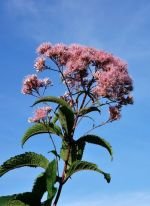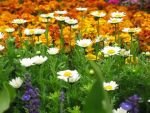Johnson Grass
Johnson Grass/Johnsongrass (Sorghum halepense)
It may come as a wonder to some why a butterfly garden site is concerned about grass weeds. For two reasons:
- Any beginner gardener trying to save money thinking a weed like this could possibly be used as ornamental grass needs to be warned. See the about me page for my story.
- Seeds are pollinated and many times have made their way into gardens, or they started out in soil that eventually becomes the new garden.

| Photo: dok1 - Don O'Brien |
This is not one
of those grasses that should be considered as ornamental anywhere on property.
Originally from the Mediterranean Region, it was cultivated for forage and soil erosion. This tall and coarse clumping perennial, also known as Millet Grass, grows anywhere from open pastures to disturbed soils.
It likes moisture and is found near water, irrigation ditches and is more troublesome than most grassy weeds. It's not likely to be found in turf, but probably along roadsides we travel daily.
Johnson Grass grows in dense clumps of alternating rough leaf blades. Leaves grow long, up to 20 inches with a distinctive raised white vein in the center running the length. If leaves have purple blotches on them it is a bacterial disease to weed.
Stems growing from the leaf cluster average 7 feet tall but can grow higher. These stems have a light to dark red base and at the top sits a large flower head, or panicle, that resembles a pyramid in outline.
The large, open panicles consists multiple branches each having one primary spike that has three spikelets fanning from it. It is from these spikelets that the thousands of flowering seeds shatter easily. Flowers are oval-shaped and are a purplish to dark reddish-brown in color.
Preventing seed production and their spread is key. The flowers bloom from May up until October, or the first frost.
This competitive weed is very aggressive and can choke out other vegetation and is considered noxious to animals if eaten in large quantities. It reproduces through seed and underground rhizomes, which can be extensive. Rhizomes are usually produced in the top 10 inches of soil but have been found spreading as far down as 5 feet.
If hand pulling new weeds do so in the summer and wait until a rain provides moist and pliable ground in order to get the full rooting system. If weed can be mowed, do so. It does not grow well in frequent, close mowing situations.
Resistance has appeared with herbicides. It is recommended to try different kinds of post-emergents, including glyphosate. Vinegar weed killer has also worked well. Remember that both vinegar and post-emergent herbacides are non-selective, so they will kill everything they come in contact with. Apply with caution.
Back from Johnson Grass to Weed Identification
Back from Johnson Grass to Easy Butterfly Garden.com
 Copyright © 2010-2015 Easy-Butterfly-Garden.com
Copyright © 2010-2015 Easy-Butterfly-Garden.com
Privacy Policy Disclaimer
 Print Print
|

Join Easy Butterfly Garden on Facebook
Recent Articles
-
Daylillies
Sep 27, 15 12:13 PM
Daylillies attract all kinds of butterflies and are a very durable plant, even in winter. Cultivers come in different forms and colors. As beautiful as they are, there is one drawback...
-
Joe Pye Weed
Sep 13, 15 02:11 PM
Joe pye weed looks great in a more casual garden setting. It's not considered invasive but between the many seeds and the fast growing rhizome system, it needs to be controlled.
-
Daisy Flower
Aug 30, 15 03:37 PM
The up-side to the daisy flower is that it is up when the sun is feeding pollinators. The down side is that one particualar species is invasive.
-
This Gardening and Butterfly Websites Sitemap
Aug 16, 15 11:34 PM
This gardening and butterfly websites sitemap for easier navigation.
-
Calliopsis
Aug 16, 15 11:28 PM
Calliopsis is a name shared by other flowering plants in the Asteraceae familiy. These include Tickseed and the Coreopsis perennial.





New! Comments
Have your say about what you just read! Leave me a comment in the box below.